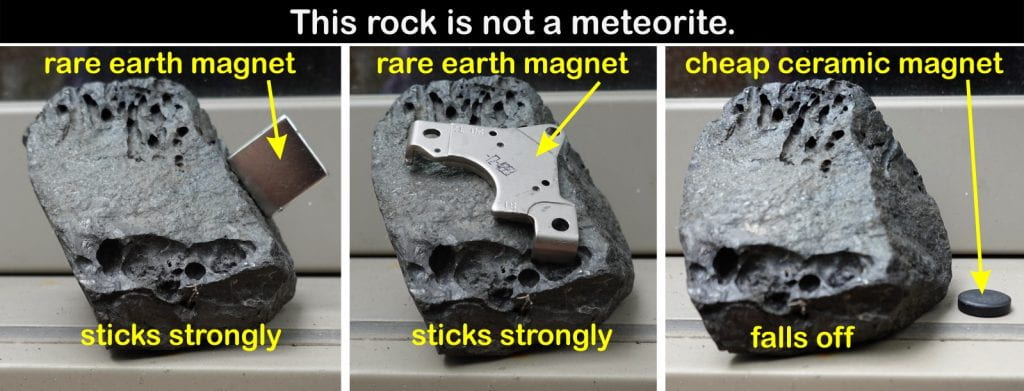Magnetic attraction
If you have a rock that does not attract a magnet, then almost certainly it is not a meteorite
Meteorites are not “magnetic.” Meteorites are not magnets – they do not attract paper clips or pins. Most (>95%) meteorites (chondrites, iron meteorites), however, do attract a magnet because they contain a lot of iron-nickel metal.
If you have a rock that does not attract a magnet, then almost certainly it is not a meteorite. Some of the rarest kinds of meteorites (achondrites, lunar meteorites, martian meteorites), however, do not attract magnets because they contain little or no metal. Most terrestrial (Earth) rocks also do not attract magnets for the same reason.
If you have a rock that does attract a magnet, then it is also probably not a meteorite because the mineral magnetite is common in Earth rocks. Cut or break the rock open. If it has metal flecks or veins like in these ordinary chondrites, then it might be a meteorite, but more likely it is just industrial slag, which often contain metal blebs.

Do not use a neodymium (rare-earth) magnet. Those things are so strong that they will attract many kinds of terrestrial rocks. An ordinary chondrite or iron meteorite will respond to an inexpensive ceramic or ferrite magnet. In the U.S. we often call these “refrigerator magnets.”

If you have a piece of metal that does not strongly attract a ceramic magnet, then it is definitely not a meteorite.
If you have a piece of metal that does attract a magnet and want to know if it is an iron meteorite, obtain a chemical analysis for the elements iron (Fe), cobalt (Co), nickel (Ni), chromium (Cr), and manganese (Mn). Iron meteorites will have 75-95% Fe, 5-25% Ni, 0.2- 2% Co, and <0.1 % (<1000 ppm) each Cr and Mn. A metallurgical lab can provide this analysis. In the right hands, a hand-held XRF analyzer can also be useful.



